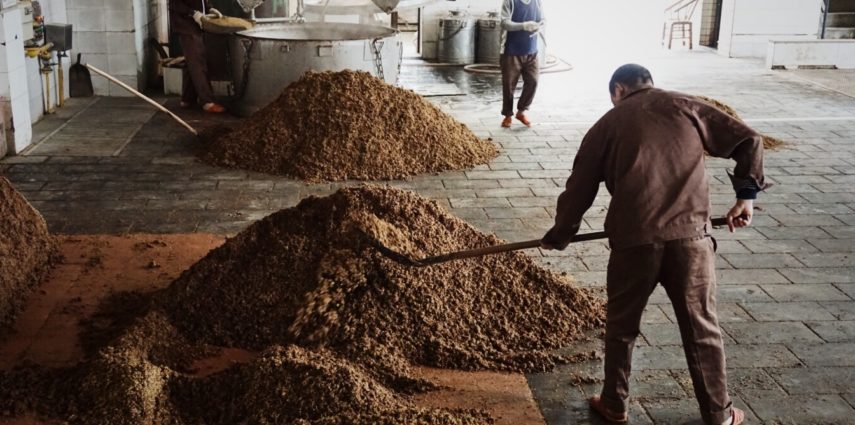The ancient boozey secrets of Baijiu
Baijiu is a mysterious, complex drink and its nuances elude many uninitiated drinkers. That complexity starts, quite literally, with wild yeasts, and bacteria. In Sichuan where baijiu was first produced, it is still made in giant underground, mud-lined fermentation pits. We were afforded the rare opportunity to get a first-hand look at the whole baijiu making process, at one of the biggest and oldest producers in China – Jian Nan Chun.
The Jian Nan Chun distillery is located in MianZhu, about an hour north-east of Chengdu. It is famous, not only as one of the biggest producers in China, but for having the oldest fermentation pit in continuous use. The baijiu produced here was also famous for ‘inspiring’ specific poems and writing in general by famous historical poets LiBai and DuFu. Both men’s penchant for the drink was no secret.
Sichuan is where baijiu production was believed to have developed, and the ‘strong aroma’ variety still made here is one of the most interesting and unique varieties. Strong Aroma baijius use the poetically named ‘10,000 year pit’ and ‘never ending mash’ which make it fascinating from a fermentation perspective as well as for the drinker.
Jian Nan Cun 剑南春
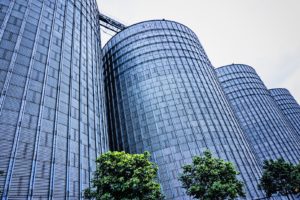
The modern facility at Jian Nan Chun
Baijiu’s key distinguishing factor is that the grains are solid-state fermented. With most alcohols, grains are first sacchirified and then fermented with the addition of yeast, in a liquid state. The most important element in making baijiu is the use of ‘Qu’ in place of a single yeast. The Qu is made of fermented grains, in Sichuan usually Sorhgum or wheat. But wild yeasts grow abundantly, and they are fostered and formed into dense bricks that contain dozens of yeasts and fungi and bacteria. This Qu is able to saccharify and ferment the grains in a single step, without the addition of water.
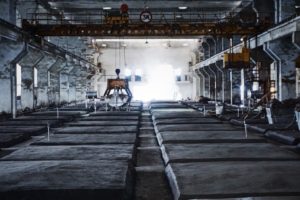
Mud covered fermentation pits
This fermentation takes place underground, in large mud-pits, and the living organisms of the qu inhabit the walls and grow and multiply. So the value of a particular baijiu often stems from the history of its pit, both in legend and in reference to the amount of active organisms which inhabit it. A new pit, has no history, no allure and, literally no culture, so often very little value. Pits of a few hundred years old can sometimes have 1000’s of active organisms within them, though some of the magic comes from the fact that it is hard to control and regulate (or count them), and there is always an element of mystery.
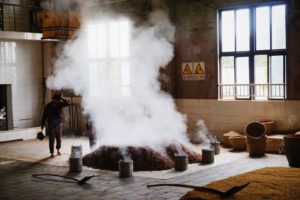
Steamed Sorghum awaiting fermentation
Steamed grains, typically sorghum and sometimes with the addition of wheat, corn, rice, millet or sticky rice, are thrown in the pits with powdered Qu, and covered with mud bricks. The fermentation period of Strong Arom baijiu is often 90-120 days. The wildness of the yeasts means that they react differently to their environment everyday, based on humidity and temperature. Very different products can be produced on different days from the same ingredients.

Shovelling the grains onto the cooling pad
When the pits are opened the grains are spread on the floor to cool before they are added to the distiller. Unlike most alcohols which are distilled in a liquid state, boiling and evaporating the liquids, baijiu is also solid-state distilled. This process passes steam through the grains and heats them to higher temperatures and extracts chemical properties from them we don’t see in other alcohols. This may account for a lot of the big, surprising and fruity tastes of baijiu. After distillation, about 50% – 2/3rds of the grains are thrown back in the pit and mixed with fresh grains and more Qu – hence the never-ending mash idea.
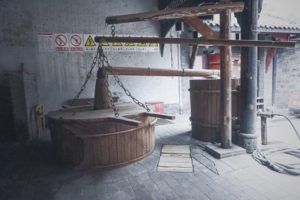
Ye Olde-Skool distiller
Jian Nan Chun is believed to have the oldest pit in continuous use, more than 1500 years. In fact its 4 pits, and the small batch baijiu produced from grains fermented there can sell for thousands of dollars a bottle. Pictured above, is the old wooden distiller and condenser, still used to distill the grains from these pits.
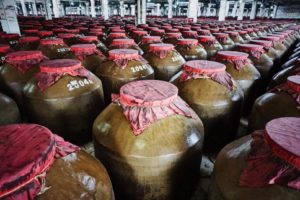
That’s alot of baijiu
Baijiu is aged in earthenware jars, usually for 3 or more years. Each jar representing a different batch. Because each batch can be so different, a master blender is employed to mix the various baijius to recreate the exact flavor profile of the brand and its sub-brands. Baijiu aged longer and from older pits tends to be more expensive. Unlike spirits aged in casks, baijiu absorbs some minerality from the earthenware jars and begins to mellow in flavor.
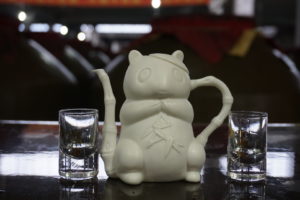
Just a taste?
Baijiu is then mixed with water, to reduce it to its standard 52% ABV – which is to say that the strength of it is calculated and on purpose. While some are sold as high as 64%, many higher end baijius can be between 40-50%. Don’t let the cute little panda, bamboo carafe fool you – this fresh stuff straight out o’ the jars was almost 70%.
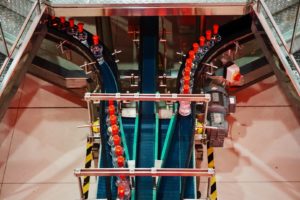
The magic of machines
The different baijius at each factory are then sent through a series of standardized scientific tests. These check their alcohol percentage, and test for impurities and irregularities before they are bottled, and labeled and shipped off to the drinkers of the nation.
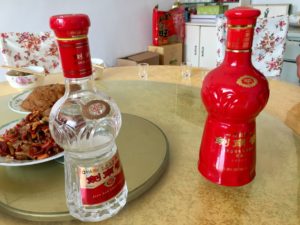
GanBei! Hao, Hao, Hao!
…Or sometimes they are sent straight to your dinner table full of local food, and inevitably followed by jovial conversation and good times.
We hold regular baijiu tastings, events and field trips with our sister Company Chengdu Baijiu Club. Please reach out if you are interested in learning more (or drinking more) about baijiu.

